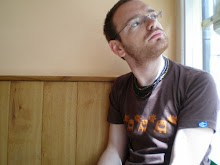Having finished The Wire, I’m now partway through the second season of Dexter. It’s not thought of as being in the same class as David Simon’s show, but certainly it’s gripping stuff and is characterised by a visual flair which is never more evident than in the opening credits.
The show, if you are unaware, focuses on Dexter Morgan, who works for the Miami Police Department as a blood spatter expert, but is also a serial killer.
Because of a code devised by his adoptive father Harry, Dexter is able to manage his urges in such a way that he only kills ‘bad people’ and in such a meticulous way that he seems certain not to be discovered.
There are many things to love about the show, such as Dexter’s foul-mouthed sister Deb, of whom I recently told a startled colleague: “She’s my favourite character in any show ever. I love her. It’s not a crush; I actually love her.”
The second season also introduces us to possibly my least favourite character in any show ever, Lila, a drawling, nasal, languid Englishwoman who at one stage mutters the unforgettably irritating line: “Paaaaaaaaaardon myyyy tits.”
A glorious constant, though, is the credit sequence – surely the finest TV has ever seen, and something which, were I still at university, I’d be looking for an excuse to write an essay about.
It takes us through Dexter’s morning routine as he shaves, flosses, dresses, cooks and eats breakfast, before leaving the house on his way to, well, somewhere.
The sequence’s genius is in how it implies the proximity of death in everything Dexter does, from the moment he awakens to slap a blood-thirsty mosquito on his arm.
The extreme close-up of his face as he shaves reduces his flesh to the same status as the bacon he cooks and eats.
A cut sees blood splash across the white bathroom porcelain, just as red sauce stains his plate as he twists his knife in the vibrant, lifeless yolk of an egg.
Power is in his hands as he grips and plunges his cafetiere, slices and squeezes the juice out of an orange, or pulls taut his dental floss and shoe lace.
Finally there is a suffocating thrill as he puts on his t-shirt, before looking conspiratorially at the camera.
It perfectly encapsulated the show’s menace and dark humour – and rightly earned an Emmy for creator Eric Anderson.
More than that, though, as something that takes the mundane and shows it in a new, vibrant, visceral way, I would contest it is art in the truest sense.
How close am I to death as I plod through my daily routine?
Am I close to drowning as I sink into my morning bath? When I put on a tie, am I an enthusiastic tug away from strangulation? Could ceding to a mischievous, mistimed impulse send my car careering off the motorway or into another vehicle – or, just as pertinently, another vehicle into mine?
The sequence shows us that death is a constant, lurking presence in our lives.
Its proximity frames and informs everything we do. It is a constant motivation. It’s the reason we don’t just stay in bed all day, but seek to inject meaning into everything we do. It is the clock on our action, our deadline.
It also gives us power. Every day we decide to continue living. On some level, we all decide to let others continue living too.
It is the most basic counterbalance in every relationship we ever have, from someone passing you in the street who doesn’t push you in front of a car, to the person who makes you tea and does not poison it, to the person who sleeps beside you and keeps their pillow below their own head, not on top of yours.
If this sounds morbid, it is exactly the opposite. It is the most basic human courtesy from which all respect emanates – it shows good in every person you’ve ever met and inspiration in every day you’ve ever lived.
There’s no particular conclusion to these thoughts. There doesn’t have to be. But any show which could inspire them and more is worthy of attention. A title sequence which can illicit them is something to be savoured.
Subscribe to:
Post Comments (Atom)

No comments:
Post a Comment